
Becoming one family
Social action, common good style
The “cost of living crisis” is prompting many churches to respond by increasing social action. But can social action always be described as common good? Catherine Brady describes how the approach taken by her and fellow parishioners has achieved way more than their initial aim to feed hungry children. “Grub Club” followed common good principles and has grown into a multi-dimensional patchwork of flourishing local relationships. Instead of a transactional, “service-client” delivery model – where nothing is asked of the recipient, their approach has been fundamentally relational and reciprocal, allowing the receiver to give, and the giver to receive, building a mutually beneficial sense of one family – a common good.
Our first instinct was to feed hungry children
It all started in 2018. Half a dozen of us sitting around the table debating the meaning of ‘action’ in social action (according to our own Catholic tradition). We belonged to a large and relatively affluent church community ‘on the university side of town’, popular for church services but having little engagement with the wider neighbourhood. Believing that our faith compels us to support the poor in very real and concrete ways and to work in solidarity for justice, our small group prayed and asked for guidance: How can we make a difference within our local community?
The answer came through a parishioner who gave witness to the challenges some families have in feeding and entertaining young children during school holidays. We did our research re local provision, engaged the parish priest, established a core leadership team, wrote a constitution and joined an organisation called Make Lunch (now part of TLG) whose advice was critical in helping us to scope the scheme and get us off the ground. Grub Club was born: fun and hot food for disadvantaged children of primary school age and their families.
Trusting the Spirit
Right from the start we engaged the support of parishioners via church newsletter, pulpit and social media. Conscious of people’s time (and attention spans) we held an open meeting; tight agenda, no slides, forms on hand to complete, refreshments provided. Much to our delight, the hall was full and we found we didn’t recognise half the attendees. As it was our intention to go beyond our own Catholic parish, seeing it as a community rather than parochial scheme, this was another sign that we were on the right path. As our network expanded word got around and volunteers came forward.
With the benefit of hindsight we recognise that our conversations, prayers, reflections and insights were all part of a process of discernment. Inexperienced in this enterprise, we didn’t know what we didn’t know. But it didn’t matter, we were fired by the Spirit. Obstacles came and fell away. People we needed emerged from places we hadn’t thought to look. We never worried about money. As soon as word got out donations poured in, many from parishioners who felt they ‘could not do anything practical’ but wanted to support us.
Grub Club: a few facts
Having a team of committed individuals with specific responsibilities was critical. We established a core team of ‘do-ers’ and a back-up team of ‘pray-ers’.
Volunteers worked on kitchen duties, activities, meet and greet, school liaison, communications, training. Duties were matched with talents and preferences.
Children and volunteers ate a nutritious three course meal (at least one hot course).
Activities included art and crafts, games, sport, reading, dance and more.
We grappled with compliance, spoke to the relevant authorities, completed food safety, first aid, safeguarding training, carried out DBS checks.
We opened Grub Club for ‘lunch and fun’ for four hours, three days a week in July 2018.
During the first six weeks we served 380 meals to children, siblings, carers and volunteers.
Then Covid hit and our activity was restricted to food distribution.
After Covid, a broader alliance forms
Keen to resume but losing most volunteers and key members of our core team, we made the decision to reopen and had to re-establish our presence quickly, with six weeks’ lead-time. Due to the unavailability of the Catholic school we had to find new premises. What seemed like a set-back proved to be a blessing. Since we’d formed alliances with other churches and community groups we were offered a home by the local United Reformed Church team and jumped at the chance to become a town rather than church initiative. The minister’s wife joined the core team.
As members of the council-supported Charnwood Food Poverty Action Group, we were also part of a larger network. This helped our messaging and mission as it’s important to ensure that your offer is complementary to that of other organisations rather than duplicating effort. I attended a Churches Together leaders’ breakfast and asked ministers to spread the word to families. We leafleted the libraries and contacted the university, social services and health centres.
Volunteers aged 18 to 80 came from parishes and beyond, people of other faiths and no faith, neighbours, colleagues, friends and family members. Financing the scheme, recruiting, training and briefing volunteers, organising and running the sessions, meeting compliance standards were all straightforward to administer.
One family: beneficiaries involved in leadership
We’ve found that the greatest challenges are to target those families in need and to encourage them to step over the church threshold. We make great efforts to get to know and involve parents/carers. One parent now sits on our core team and her insights on approaches to take with parents have proved invaluable.
Other parents and carers, now familiar with the set-up, come forward to suggest and organise activities. Volunteers are asked to sit amongst the families at lunchtime. Becoming one family together at the table is important for so many reasons: people open up; no distinctions are made; relationships are formed.
We encourage volunteers not to make judgments and to respect each person’s dignity, working on the common good principle that everyone is included, no one left behind. There are books and activities for younger siblings. Disabilities and allergies are identified at registration and efforts made to accommodate. After a hesitant start and clinging to Mum, two children with autism (they wear badges) join in with the rest. There are spaces they can go if it gets too noisy and other children respect their place at the front of the lunch queue.
Everyone benefits – intergenerational reciprocity
Aside from the obvious benefits of feeding people and helping to create happy memories for children, there have been some unexpected benefits. Volunteers, many retired from a life of family and work, have reported that they ‘have felt valued and valuable’ again. Some said they felt ‘less isolated’. Some have made new friends.
With a little encouragement dormant skills and qualities come to the fore. The elderly lady who confided she ‘wasn’t good with small children’ and ‘unsure whether to sign up’ was later observed sitting on the carpet helping a child with a jigsaw. She later wrote ‘thank you for a very enjoyable and educational experience… I learned a lot and had never done anything like this before.’ One 85 year old volunteer, a former crafts teacher, did one-to-one sessions with children less inclined to join in group activities. She told us that using her skills again in this way had reinvigorated her. The young volunteer, given time off from her professional career to spend on community action, told us that it had opened her eyes to the ‘hidden poverty’ within her own town.
Growing naturally, through local relationships
Not content with running a lunch and fun club we decided to offer a couple of warm hubs. Volunteers have been recruited from two local churches.
And learning that some children attend school in winter months with inadequate clothing, we started a coat initiative in 2018, collecting and distributing 500+ coats. We engaged six local secondary schools to sort and collect and we are doing this again in 2022, using the council food bank and a local charity as distribution centres.
Another relationship is being forged with a local GP who wants to engage with the local community to offer support beyond the medical to people whose needs she perceives are not being met within her own practice.
A common good model
Everything we have done has been achieved by establishing relationships, often with people who might not have seemed to be ‘natural bedfellows’. Great ideas come from everybody and individuals often surprise themselves with what their efforts achieve.
We have learned to listen and discovered that the best ideas come from all quarters, including the children themselves. We have moved from a service model (we do things for others) to a common good model (people are included from the start to help themselves.) To be honest, we would not have articulated our ways of working as ‘the common good model’ but that’s what it is.
We recognise that listening and good decision-making are features of discernment. The Spirit is always ahead of us and truly moves in mysterious ways. We don’t know where we are being led but that’s ok.
Catherine Brady
After a first career in teaching, Catherine Brady started a training design company, and for the last 30 years has worked with many clients in the UK and internationally, including Marks & Spencer, Nuffield and others. Catherine is also co-founder and Chair of Grub Club, a volunteer-run initiative in her parish feeding children in school holidays. Passionate about releasing the social action potential of Catholic laity, Catherine believes capacity can be built by strengthening church-based training and formation. Catherine is a former T4CG Trustee and Associate.
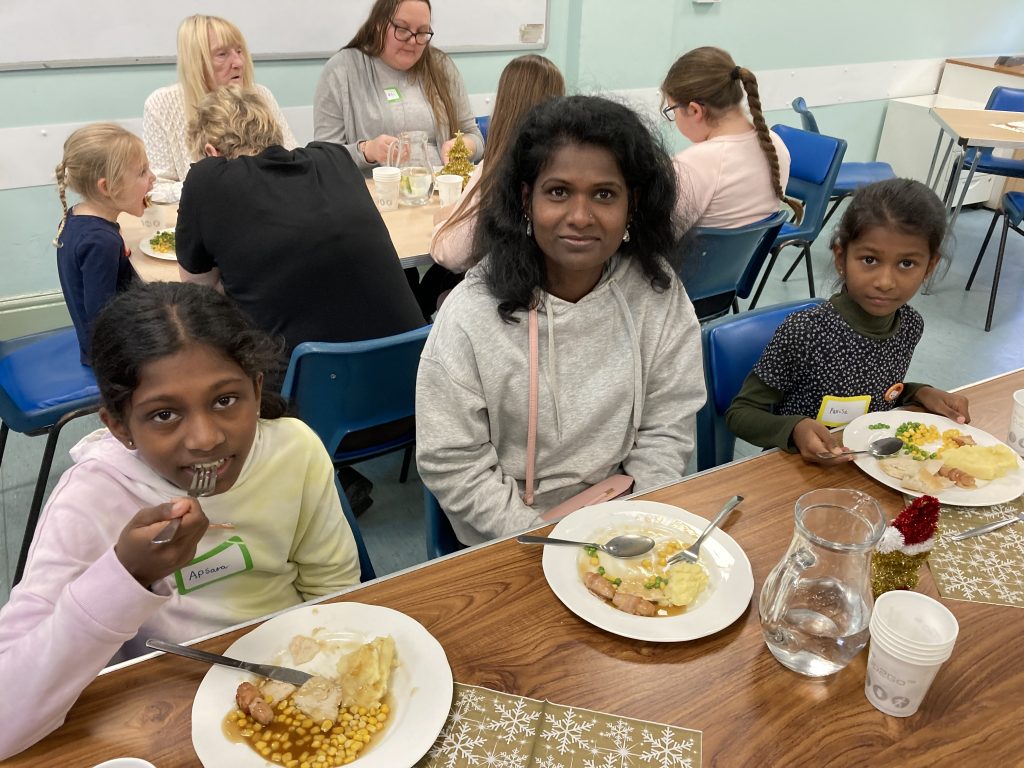
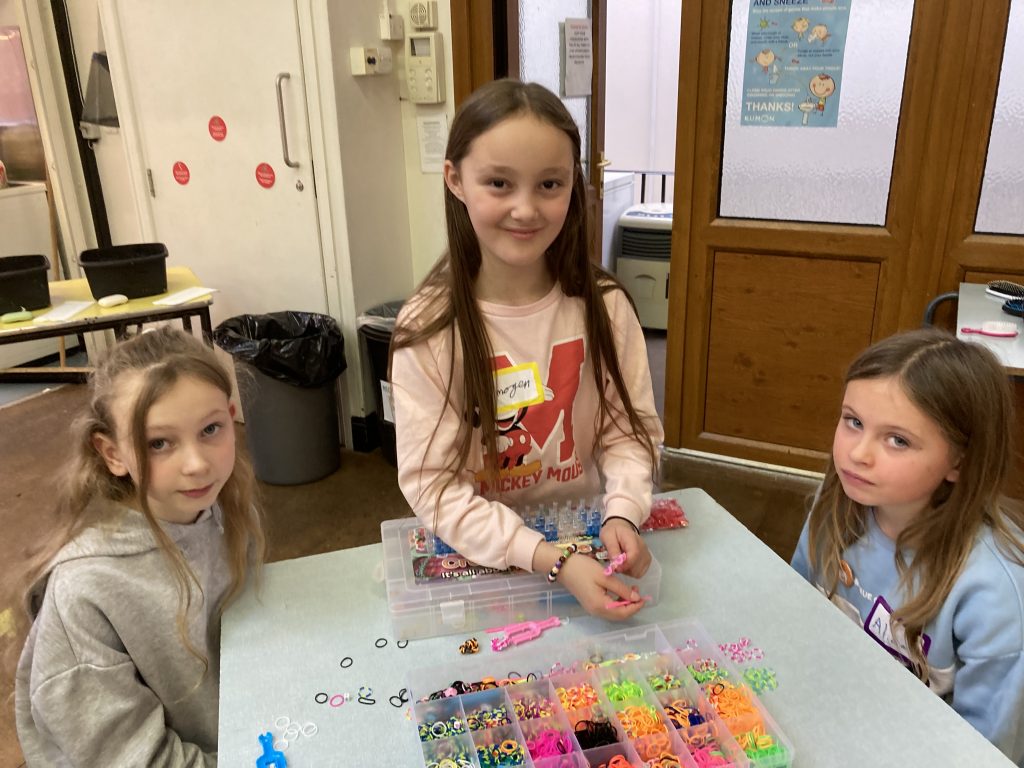
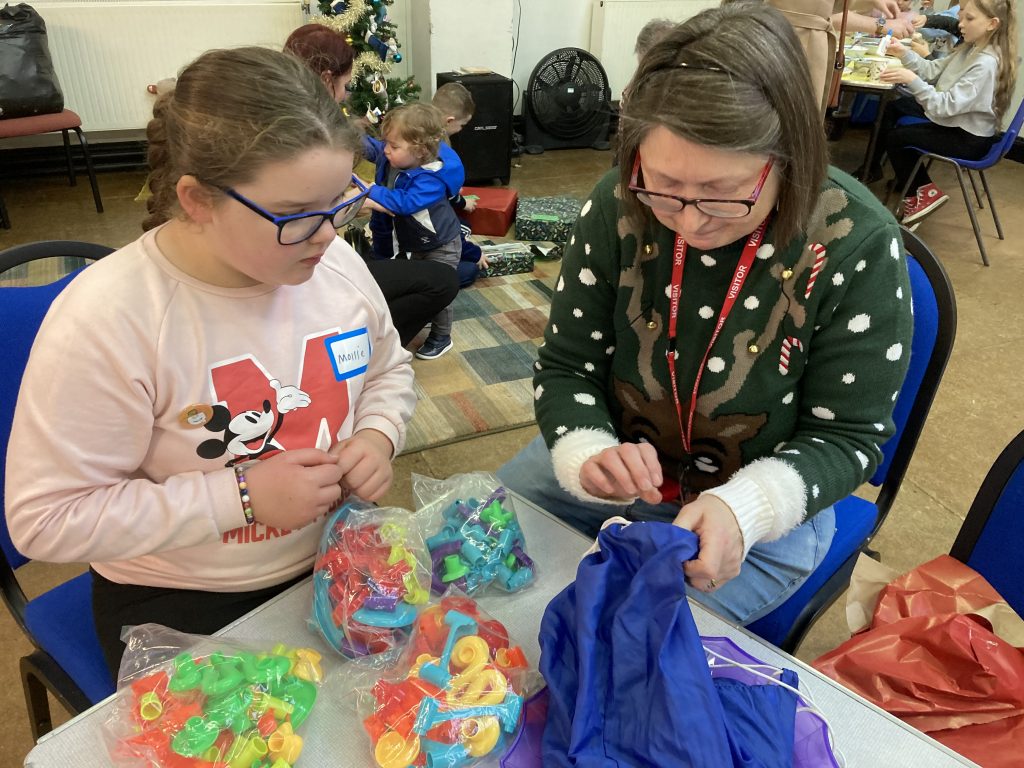
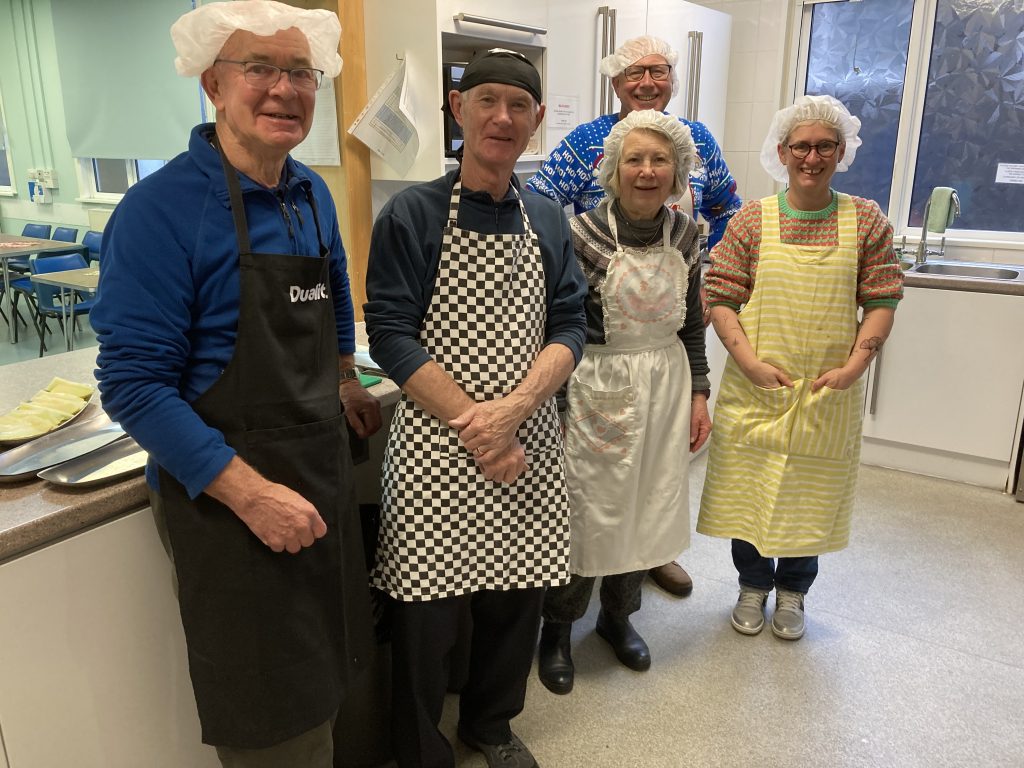
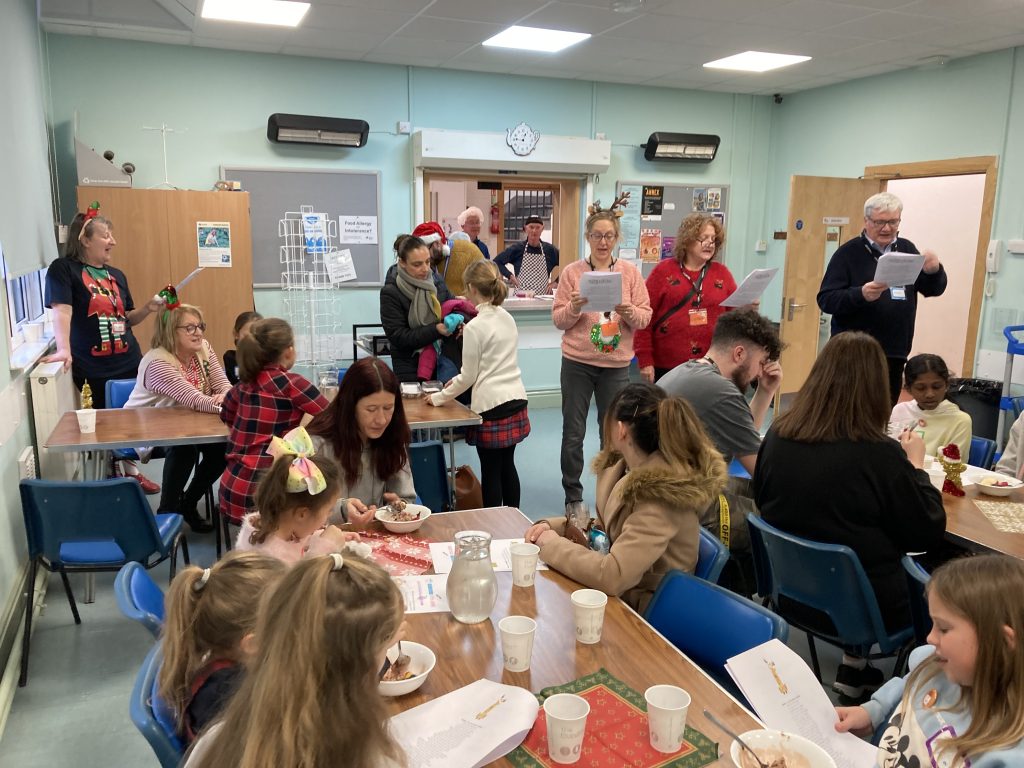
Photos: Grub Club
